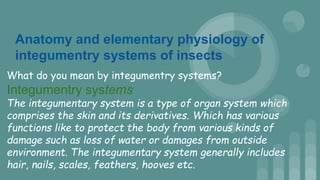
Anatomy and elementary physiology of integumentry systems of insects
- 1. Anatomy and elementary physiology of integumentry systems of insects What do you mean by integumentry systems? Integumentry systems The integumentary system is a type of organ system which comprises the skin and its derivatives. Which has various functions like to protect the body from various kinds of damage such as loss of water or damages from outside environment. The integumentary system generally includes hair, nails, scales, feathers, hooves etc.
- 2. Integument Integument is outer covering or body wall of insects which is ectodermal in origin. It is rigid, flexible, lighter, stronger and variously modified in different structures. Functions of integument or body wall : ● Protection or Mechanical damage ● Absorption ● Excretion and Secretions ● Sensitivity ● Transpiration or geseous exchange ● Aesthetics etc.
- 5. Basement membrane ● Made up of thin and fibrous layer of mucopolysachcarides and collegen fibers. ● Digestion and Absorption of cuticle ● Supporting structure for all layers of cuticle Contain accessory pigment cells in insects Consists of two layers : 1. Basal lamina - consist Epidermal cells 2. Reticular lamina - contain heamocytes and fat bodies.
- 6. Epidermis ● Single cellular layer ● Forms plasma plaques that are site of secretion for the outer Epicuticle and chitin fibers ● Zonulae adherence - apices and septate junction - lower side together held epidermis ● Contain E. R., golgi bodies and pigmented cells also ● Glandular layer of the integument that have digesting and moulting enzymes for the cuticle ● Cordinariom between the Epidermal cells is
- 7. ● Epidermal cells contain 3 type of specialised Glandular cells : 1. Class 1 2. Class 2 3. Class 3 ● Class 1 - these are specialised for pheromone production ● Contact with cuticle through pore canals and Epicuticular filaments
- 8. Class 2 cells ● No contact to cuticle ● Have No ducts ● Only known from the sterna glands of teemites Class 3 cells ● Contact through ducts ● Forms the End apparatus and secreate cement on outer surface of cuticle ● Have defensive sections and pheromone sections
- 10. Oenocytes ● Derived from the Epidermal cells ● Synthesise Hydrocarbons and lipids that contribute to the Epicuticle ● Transport Hydrocarbons through heamolymph and lipids directly through the cytoplasmic strands ● Hydrocarbons also function as sex hormones in some species of insects ● These are generally large that is about 100 μm in diameter
- 11. Cuticle It is outermost thick layer of the integument. It is complex and non cellular. It forms from the Epidermis or it is a Secretions of Epidermis. It is rigid or flexible that differ in different parts of the body. It is divided into : 1. Epicuticle - upper 2. Procuticle - inner ○ Exocuticle ○ Endocuticle
- 12. Epicuticle Multilayer generally 4 layers Thickness is about 1- 4μm Generally Chitin is absent in Epicuticle Different layers of Epicuticle : 1. Inner Epicuticle 2. Outer Epicuticle - non chitinous 3. Wax layer 4. Cement layer
- 13. 1. Inner Epicuticle ● Tanned layer ● Contains phenol and polyphenols ● Thickest layer 2.outer Epicuticle ● Made up of polymerised lipoprotein ● Thiner layer also called as trilaminar layer ● Nonchitinous layer
- 14. 3. Wax layer ● Made up of Hydrocarbons ● Contain Oenocytes (Desication) Transported through pore canals 4. Cement layer ● Secreted by Epidermal layer or dermal gland ● Made up of lipoprotein ● Protects the body from external damages
- 16. Endocuticle ● Age determination layer by vertical striations ● It is darkly pigmented ● Hard and sclerotised ● Consists mainly hard protein sclerotin and chitin Exocuticle ● Present in hot bodies insects ● It is non digested layer ● It is lightly pigmented ● Soft and non sclerotised ● Consists of mainly more chitin
- 17. Composition of Procuticle 1. Chitin 2. Proteins 3. Lipids Chitin - polysaccharide of NAG molecule i.e. N-acetyl glucosamine that are linked through β(1- 4) linkage ● Adjescent chains form microfibrils embeded in protein matrix and ranges about 2.5 to 3nm ● Ritate in particular direction to form helecoidal and parallel structures
- 20. Moulting It is process of shedding or casting of the old cuticle and the formation of new one Processes involved in moulting ● Behavioural changes ● Apolysis ● New Epicuticle formation ● Deposition of Procuticle ● Ecdysis ● Expansion and sclerotisation
- 21. Behavioural changes ● Stop feeding and become inactive ● Mitotic divisions take place ● Increase tension between Endocuticle and epidermis Endocuticle Epidermis
- 22. Apolysis ● Separation of the Endocuticle from epidermis ● Suvcuticular or exovial space formation
- 23. Formation of new Epicuticle ● Forms as patches at the tips of microvilli of the epidermal cells ● Polyphenols and phenoloxidase are produced to stabalise the Forming Epicuticle
- 24. Digestion of old Endocuticle ● Digested by enzymes of epidermal cells like chitinase, proteases and aminopeptidases ● These are generally in inactive form until the new Epicuticle is formed ● Activated by active transport of k+ions in exovial space ● Enzymes digest all unscleriotised cuticle except the ecdysial membrane,Exocuticle, muscle and nural connection to old cuticle ● Products are reabsorbed generally though the integument
- 27. Ecdysis ● By increasing blood volume the insects split the old cuticle that exert pressure from inside ● In preparatory phases it swallows air and water in Gut to increase the pressure of heamolymph ● Head and thorax comes out first then abdomen and appentages ● Blood volume is very high so it provides the hydrostatic skeleton
- 28. Expansion and sclerotisation ● cross-links between protein molecules to form a rigid matrix. The process of cross-linking is called tanning or sclerotisation. ● N-acetyldopamine and N-alanyldopamine are two compounds known for sclerotisation ● These are oxidised to quinones by phenoloxidases ● Expansion involves swallowing of air and water. ● changes in orientation of chitin microfibrils ● Stretching of the body cuticle thickened the cuticle layers